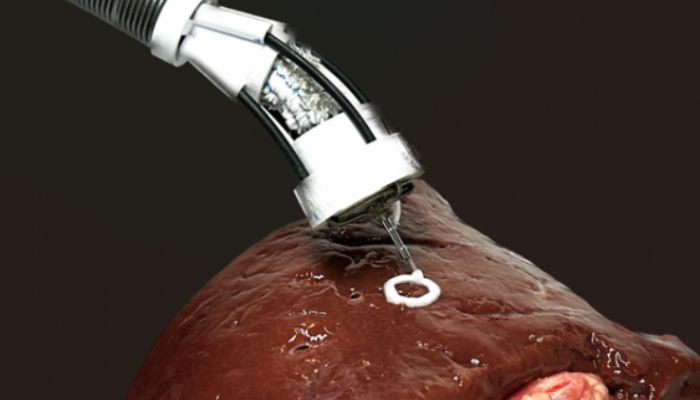Tiny robot can 3D print biomaterials inside human body
Before 3D printing on organ surfaces, study team tested device within artificial colon where it was able to move through small openings
March 02, 2023

A new device can 3D print living cells within the human body. A prototype endoscopic surgical equipment that may be used directly on internal organs is being unveiled by researchers in Australia. Engineers at UNSW Sydney claim that the soft robotic arm, which is small and flexible, can 3D print biomaterial straight onto a patient's internal organs.
By using a technology called 3D bioprinting, biomedical components with the appearance of real tissue can be created. The main applications of bioprinting are in research, including tissue engineering and the creation of novel pharmaceuticals. Cellular structures that are created outside of a living body typically require the use of big 3D printing machines.
Before successfully 3D printing on organ surfaces, the study team tested the device within an artificial colon where it was able to move through small openings. This effort was directed by Dr Thanh Nho Do of the UNSW Medical Robotics Lab and his PhD student, Mai Thanh Thai, in cooperation with other UNSW researchers, reported Study Finds.
The bot's tiny, flexible 3D bioprinter can directly distribute multilayered biomaterials to the surface of internal organs and tissues while being able to enter the body like an endoscope. Scientists can remotely control the F3DB proof-of-concept gadget, which has a highly movable swivel head that "prints" the bio-ink and is joined to the end of a long, flexible robotic arm that resembles a snake.
According to the research team, with further advancement and possibly within five to seven years, the technique could enable medical personnel to access challenging body regions through minute skin incisions or innate orifices. Dr Do and his team used 3D printing to create a variety of materials with various forms on the surface of a pig's kidney as they tested their device inside an artificial colon.
“Existing 3D bioprinting techniques require biomaterials to be made outside the body and implanting that into a person would usually require large open-field open surgery which increases infection risks,” said Dr Do, a Scientia Senior Lecturer at UNSW’s Graduate School of Biomedical Engineering (GSBmE) and Tyree Foundation Institute of Health Engineering (IHealthE), in a university release.
“Our flexible 3D bioprinter means biomaterials can be directly delivered into the target tissue or organs with a minimally invasive approach. This system offers the potential for the precise reconstruction of three-dimensional wounds inside the body, such as gastric wall injuries or damage and disease inside the colon,” Dr Do added.
“Our prototype is able to 3D print multilayered biomaterials of different sizes and shape through confined and hard-to-reach areas, thanks to its flexible body.”
The research, conducted in collaboration with Dr Hoang-Phuong Phan, Associate Professor Jelena Rnjak-Kovacina, and Scientia Professor Nigel Lovell, is published in the journal Advanced Science. The technology has been given a provisional patent and will now undergo in-vivo testing on live animals to show how it may be used in practice.
The researchers also want to add features like an integrated camera and a real-time scanning system that would rebuild a 3D tomography of the body's moving tissue.









